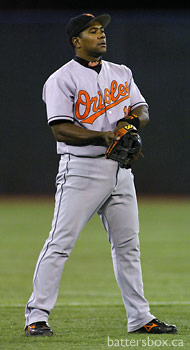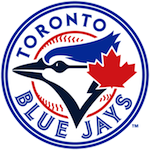 Tejada was signed by the Oakland Athletics as an amateur free agent in
1993 at age 17, and spent two summers in the Dominican League.
The A's moved him to Low A ball in 1995, where he hit .245 with medium
range power and very good plate discipline. He stole 19 bases in
21 tries over 74 games. The following year, he was moved up to
High A, where he hit .279 with 20 homers. His plate discipline
was not quite as good as the year before, but still good enough.
In 1997, he basically repeated the same season as the year before (this
time going .275/.344/.458), but at double A Huntsville. He earned
a late year cup of coffee with the big club; he hit .200/.240/.333 in
96 at-bats, and one would think that he would have earned a ticket to
triple A in 1998. It didn't work out that way. The A's had
the following options at shortstop in 1997- a 23 year old Tony Batista,
a 31 year old Rafael Bournigal, a 30 year old Scott Brosius and
Tejada. When they lost Batista in the expansion draft to the
Diamondbacks and acquired Kurt Abbott to join Bournigal as their
shortstop options for 1998, it was inevitable that Tejada would be
recalled for good earlier than would have been desirable. And so
it was. Abbott and Bournigal played like they always had the
first 7 weeks of 1998, while Tejada hit .327 with pop in double
A. Tejada got the call for good in late May, a little before he
was ready. He hit .233 with some power, 28 walks and 86
strikeouts. He took a step forward in 1999, hitting .251 with a little
more power and better plate discipline, and one more step in 2000,
improving incrementally in all departments. From 2000-2003, he
was a mainstay of the A's, hitting .280 with 30 homers a year and
anchoring the defence. He left the A's as a free agent and moved
on to Baltimore in 2004, where he has overall improved modestly on his
performance.
Tejada was signed by the Oakland Athletics as an amateur free agent in
1993 at age 17, and spent two summers in the Dominican League.
The A's moved him to Low A ball in 1995, where he hit .245 with medium
range power and very good plate discipline. He stole 19 bases in
21 tries over 74 games. The following year, he was moved up to
High A, where he hit .279 with 20 homers. His plate discipline
was not quite as good as the year before, but still good enough.
In 1997, he basically repeated the same season as the year before (this
time going .275/.344/.458), but at double A Huntsville. He earned
a late year cup of coffee with the big club; he hit .200/.240/.333 in
96 at-bats, and one would think that he would have earned a ticket to
triple A in 1998. It didn't work out that way. The A's had
the following options at shortstop in 1997- a 23 year old Tony Batista,
a 31 year old Rafael Bournigal, a 30 year old Scott Brosius and
Tejada. When they lost Batista in the expansion draft to the
Diamondbacks and acquired Kurt Abbott to join Bournigal as their
shortstop options for 1998, it was inevitable that Tejada would be
recalled for good earlier than would have been desirable. And so
it was. Abbott and Bournigal played like they always had the
first 7 weeks of 1998, while Tejada hit .327 with pop in double
A. Tejada got the call for good in late May, a little before he
was ready. He hit .233 with some power, 28 walks and 86
strikeouts. He took a step forward in 1999, hitting .251 with a little
more power and better plate discipline, and one more step in 2000,
improving incrementally in all departments. From 2000-2003, he
was a mainstay of the A's, hitting .280 with 30 homers a year and
anchoring the defence. He left the A's as a free agent and moved
on to Baltimore in 2004, where he has overall improved modestly on his
performance. Finding comparable players to Tejada is not easy. The top 5 middle infielders on BBRef.com's list of age-base comparables are Vern Stephens, Cal Ripken, Bobby Doerr, Ryne Sandberg, and Alan Trammell. Here is how they stack up, through age 30:
| Player | AB | HR | W | K | BA | OBP | SLUG | SB | CS | OPS+ |
| Tejada | 5539 | 240 | 421 | 777 | .286 | .342 | .480 | 64 | 24 | 114 |
| Stephens | 5481 | 224 | 598 | 565 | .290 | .360 | .474 | 21 | 17 | 124 |
| Ripken | 6305 | 259 | 688 | 747 | .279 | .349 | .467 | 28 | 24 | 126 |
| Doerr | 5564 | 165 | 610 | 500 | .285 | .357 | .452 | 47 | 57 | 114 |
| Sandberg | 5508 | 179 | 464 | 786 | .287 | .342 | .452 | 275 | 76 | 114 |
| Trammell | 5694 | 133 | 594 | 612 | .290 | .356 | .424 | 177 | 84 | 114 |
Stephens' statistics are a bit overstated, as some of his best numbers were posted in the wartime years. By age 30, he had moved to third base and his career was cut short by injuries. Doerr missed a year for the war, but put up good numbers in two other war years.
Assuming typical decline in his 30s, will Tejada go into the Hall of Fame? Should he? The answer to the first question seems pretty clear. I cannot imagine the voters not summoning a capable shortstop who hits 350-400 homers over his career. He may not be an automatic selection as Cal Ripken is, but as long as he can put in another 3 or 4 reasonably good years, he will in my view make it. The second question is much more interesting. So far, he has been about as good as Sandberg and Trammell. In my view, he is a little behind Trammell right now, with Trammell's edge in speed and in the OBP component of OPS worth a very slight edge. Sandberg is a tougher comparison, for they are very similar hitters. Sandberg was an excellent defensive second baseman and perhaps had more defensive value than Tejada and also had more speed. How about we say that he is generally on a Hall of Fame course, and wait a few years to try to firm things up a bit? He is, after all, only 30.




